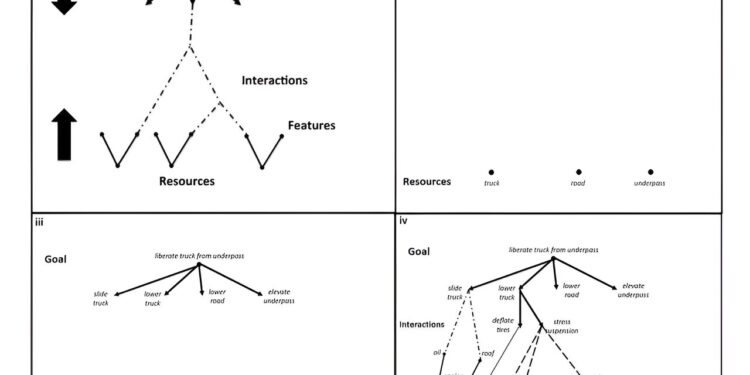An example of BrainSwarming: BrainSwarming charts were designed as a way to visualize problem solving and to facilitate the simultaneous generation of ideas in problem solving. A brief description of the problem to be solved: In the case study, the objective is placed at the top of a two-dimensional graph on any medium that allows adaptation and visualization, with the available resources at the bottom of the graph. The goal is iteratively refined downward by placing more detailed expressions of the same goal below it. Finally, a link is then created when the refined objective and the available resources are able to form a solution. Credit: Yong Loo Lin School of Medicine, National University of Singapore (NUS Medicine)
Researchers from the Yong Loo Lin School of Medicine, the National University of Singapore (NUS Medicine) and the University of Oxford have successfully demonstrated how problem-solving techniques used in engineering, known as Innovation Enhancement Techniques, can be adapted and used to improve creativity in problem solving when dealing with abstract problems encountered in healthcare and biomedicine.
Traditional “brainstorming” suffers from inherent biases, such as those related to group dynamics. To address this problem, AI researcher and cognitive psychologist Dr. Tony McCaffrey developed a suite of Innovation Enhancement Techniques (IET) based on his Dark Characteristics Hypothesis.
This new cognitive theory of innovation posits that innovative solutions typically emerge from two key stages: first, the identification of a rarely or never before noticed (obscure) feature of the elements of a problem, and second, the construction of ‘a solution based on this obscure characteristic.
These IETs are designed to enhance creative problem solving by helping individuals overcome psychological barriers such as functional fixedness, the tendency to view objects only in their conventional roles, thereby enabling the generation of innovative ideas.
These techniques were designed for engineering and design problems, which involve solving practical objectives, such as building a bridge, using physical materials, such as bricks and cement. However, health and science problems often involve solving abstract goals that may not be easily measurable, such as improving patient health, using intangible resources, such as software and data.
This work is the first to successfully apply these methods to problems in healthcare and science.
Improving creativity and idea generation in biomedicine not only fosters new approaches to healthcare challenges but also streamlines the research and development process. This can lead to faster discovery and implementation of cost-effective healthcare solutions, thereby reducing overall healthcare spending.
Example of generic parts technique: Given the example of a goal to bind two things together, the resource being only a candle, applying the generic parts technique, the composition of the candle is described as being made of wax and a wick. A more generic description is “string”, which is closely associated with linking elements together. An even more generic description of a rope with smaller parts is “long intertwined fibrous strands.” Credit: Yong Loo Lin School of Medicine, National University of Singapore (NUS Medicine)
Additionally, creative problem solving can uncover more effective uses of existing resources and technologies, potentially reducing barriers to accessing advanced medical treatments. When directly applied to bioethical goals such as justice and fairness, as in this study, IEEs can also be used to promote other ethical priorities, including increased respect for individuals’ control over their own lives as well as greater equity in health-related aspects. life.
So, to equip researchers, practitioners and entrepreneurs in various fields with innovative tools, a team led by Professor Julian Savulescu from the Center for Biomedical Ethics at NUS Medicine, alongside Dr Sebastian Porsdam Mann and Anuraag Vazirani from the University of Oxford, presented the adaptability of these techniques to generate solutions to problems with abstract objectives using intangible resources.
Their study, published in Scientific reports, illustrates this through a case study involving blockchain technology to achieve ethical goals in biomedicine, identifying 100 potential solutions using two IETS: BrainSwarming and Generic Parts Technique.
BrainSwarming begins by placing the primary goal – in this study, advancing ethical goals in biomedicine – at the top of a two-dimensional graph. This visual representation can be created on digital platforms, whiteboards or paper. Blockchain technology, a key resource in this study, is placed at the bottom of the graph. The main objective is then broken down into more specific sub-objectives.
Next, to refine their assets beyond the core Blockchain components, the team applied the Generic Coin Technique (GPT) to each artifact. This technique is used to provide new information or to help reinterpret existing information about the resources involved in a problem-solving effort by systematically breaking down the resource into its components.
Teams were then able to identify 100 possible solutions via connections between the refined goals and the available resources created and visualized, representing potential uses of blockchain technologies to advance ethical goals in clinical and research settings.
The researchers point out that their success in using these techniques demonstrates their broad applicability across all domains and problem types.
“The successful application of these techniques has vast potential to enable individuals to generate innovative ideas across disciplines. These techniques can act as force multipliers for the creative efforts of researchers, entrepreneurs and other innovators, with significant downstream benefits for individuals and society.” said Professor Savulescu, lead author of the study.
More information:
Anuraag A. Vazirani et al, BrainSwarming, blockchain and bioethics: applying innovation enhancement techniques to healthcare and research, Scientific reports (2024). DOI: 10.1038/s41598-023-50232-y
Provided by the National University of Singapore
Quote: BrainSwarming, Blockchain, and Bioethics: Applying Engineering Techniques to Health Care and Biomedicine Problems (January 12, 2024) retrieved January 12, 2024 from
This document is subject to copyright. Except for fair use for private study or research purposes, no part may be reproduced without written permission. The content is provided for information only.



